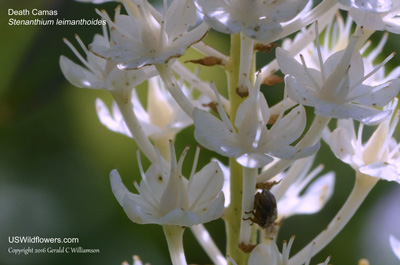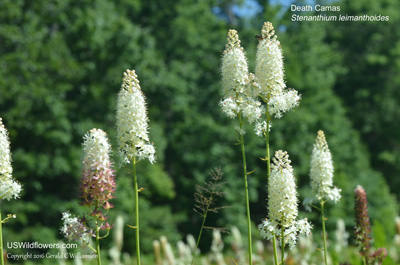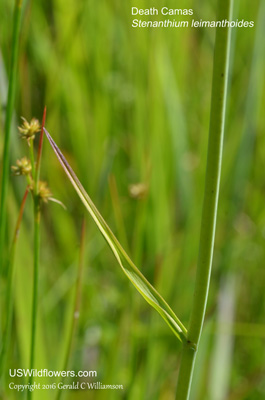Pine Barren Death Camas - Stenanthium leimanthoides
|
Stenanthium leimanthoides - Pine Barren Death Camas. Recent studies, perhaps not yet completely accepted, have reclassified (Zomlefer & Judd, 2002) Zigadenus to become a monotypic genus, with Zigadenus glaberrimus being that sole species remaining in the genus. What was formerly classified as Zigadenus leimanthoides, the plant presented here, was moved into Stenanthium as S. leimanthoides.
Stenanthium leimanthoides is a plant of diverse areas such as rock outcrops and seepages at relatively high elevations and bogs and wet pine savannas in the coastal plain. There is some question as to whether populations near the Gulf Coast belong in this species, or instead should be included within Stenanthium densum - in fact, further confusing classification, Stenanthium leimanthoides was sometimes included within Zigadenus densus (which subsequently became Stenanthium densum.) Zigadenus and Stenanthium have been moved into the Melanthiaceae family as part of the dismantling of Liliaceae.
As is implied by the common name the plants in this genus - all parts of them - are poisonous.
Found in:
AL, DE, FL, GA, KY, LA, MS, NC, NJ, NY, TN, TX, VA, WV
Leave comments on Stenanthium leimanthoides at this link. | 
Distribution of Stenanthium leimanthoides in the United States and Canada:

Blue=Native; Grey=Introduced
Map from USDA Plants Database:
USDA, NRCS. 2017. The PLANTS Database (http://plants.usda.gov, 08 May 2025). National Plant Data Team, Greensboro, NC 27401-4901 USA.
Search Our Database: Enter any portion of the Scientific, Common Name, or both.
Do a general Google search of the entire site:
#ad
 Follow USWildflowers on Twitter
| | Site: AEDC, Coffee County, TN Date: 2016-June-08 | Photographer: Gerald C. Williamson
Nikon D7000
Tamron SP 90MM f/2.8 AF Macro | The inflorescence of Stenanthium leimanthoides is a panicle - what I like to think of as a raceme of racemes. A raceme is an indeterminate inflorescence with flowers carried on the central axis on pedicels, but without branches. A panicle is like a raceme, but there may be branches of the inflorescence which are racemes, and the terminal section of the inflorescence is also a raceme. In the case of Pine Barren Death Camas, there may be as many as 100 of the white (sometime greenish) flowers in an inflorescence.
I wonder if the reddish tinting of the tepals and ovary are indicative of flowers which have been pollinated. There are reports of this type of phenomena in Stenanthium densum. | | 
| | Site: AEDC, Coffee County, TN Date: 2016-June-08 | Photographer: Gerald C Williamson
Nikon D7000 | | The flowers of Stenanthium leimanthoides have 6 tepals which are creamy to greenish white. There is a gland at the base of each which is usually yellow, and this is indicated by some experts as a means to differentiate from Fly Poison, but, as is the case with these flowers, the gland is sometimes missing the yellow color, making it effectively invisible. In fact, there is a chance I would have identified these as Fly Poison if not for the paniculate inflorescence, and the overriding fact that these had been identified as Death Camas by the Tennessee Native Plant Society. The flowers of Stenanthium are hypogynous. I had to look this up; the ovary is superior - completely above the attachment of the tepals and stamens. | | Click on the photo for a larger image

| | Site: AEDC, Coffee County, TN Date: 2016-June-08 | Photographer: Gerald C Williamson
Nikon D7000 | | At high elevations Stenanthium leimanthoides grows on rocky outcrops, on balds, and in seepage areas. At lower elevations it grows in bogs and wet pine barrens. These photographs are in a boggy meadow in middle Tennessee at around 1,000 feet elevation, where the flowers of the abundant Death Camas stood above the rest of the plants. | | Click on the photo for a larger image

| | Site: AEDC, Coffee County, TN Date: 2016-June-08 | Photographer: Gerald C Williamson
Nikon D7000 | | The leaves of Death Camas mostly basal, and relatively few - usually fewer than 10 - compared to the similar Fly Poison (Amianthium muscitoxicum), which usually has more than 10 and up to 60 basal leaves. Unfortunately the undergrowth in the location where I photographed these plants was quite dense, and I didn't get a photo of the basal leaves. The stem (cauline) leaves are much reduced from the basal leaves, sheath the stem, and are linear. The shape (keels) of the leaves might be a feature used to differentiate between species in the genus, but this photo didn't seem consistent with the leaf descriptions in the keys, and I based the species identification largely on a Facebook report from the Tennessee Native Plant Society field trip from a few days prior to my visit to this location. | | Click on the photo for a larger image

|
References used for identification and information:
|
|
| |
| #ad
|
|






